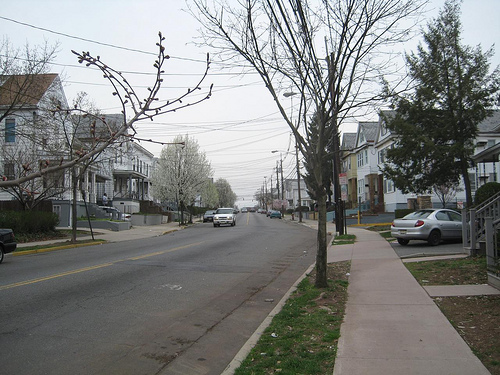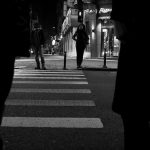How much money do road diets save?
Can road diets do more than promote safety and save space for pedestrians — can they also save cash? Turning a four-lane undivided road into three lanes, and then converting the fourth lane into bike lanes, sidewalks, on-street parking, or a combination is widely thought to benefit the primary users of the extra space, but the economic benefits are harder to distinguish. (Proponents claim that money is saved on road maintenance and reduced accident costs, among other expenses.)

A study found that a road diet in New Brunswick, NJ increased travel times, but due to lower crash rates, ultimately saved money. Image from Luis Penados.
In the study Costs and Benefits of a Road Diet Conversion, researchers Robert B. Noland, Dong Gao, Eric J. Gonzales and Charles Brown aim to discover an answer through a cost-benefit analysis of cutting down on a road’s driving lanes.
The diet in the study transformed Livingston Avenue in New Brunswick, NJ, a four-lane urban arterial street, into a street with one lane going in each direction, and a middle turning lane. Livingston Avenue is a busy street that connects many of the area’s neighborhoods, and it has a 25 mph speed limit (which many drivers ignore).
The main cost associated costs with its diet, write the study researchers, is an increase in travel time due to the smaller road. The researchers weigh the benefits of crash reductions with the costs of delays, based on the value of “statistical lives” saved against the cost of travel time. (To study Livingston Avenue’s road diet, the researchers used a software called VISSIM, which helps simulate a traffic network and can create varied scenarios.)
Some background on New Brunswick: The city adopted a Complete Streets policy six years ago. Complete Streets policies, write the study researchers, aim to balance “the needs of all roadway users, encouraging and allowing safe travel by bicyclists, pedestrians, transit users, and freight, in addition to existing car traffic. This is made possible through the transformation of the built environment and may include the installation of bicycle lanes, crosswalks, sidewalks, pedestrian signals, and transit stops… [plus] the addition of median islands, curb extensions, or the occasional road diet.”
Researchers discovered that Livingston Avenue’s road diet did, in fact, create additional costs in terms of traffic delays. However, they point out, these traffic delay costs are less than the significant benefits associated with the road diet’s result: a reduction in crashes. Just how much did the proposed diet decrease traffic? A staggering 19%.
Further, traffic in the morning was impacted less than traffic in the afternoon and evening. By adjusting signal timings and reducing traffic flow, the researchers were able to mitigate delays. (Additionally, since road diets encourage reduced speeds — which results in lower crash rates — an increase in travel time was to be expected.)
The researchers cost-benefit analysis showed “overwhelmingly positive benefits outweighing the travel time costs associated with road diet conversion.” How does that translate into dollars and cents? With a 19 percent crash reduction, they write, the net present value of road diets, over 20 years, ranges from $2.6 million to over $37 million.
The researchers completed their work in February 2014, and, in March 2014, New Brunswick’s mayor announced a road diet initiative. Two months later, three children were walking home from school and injured while crossing Livingston Avenue. Community protests called for changes to the avenue, and, soon after, the city restriped two sections of the avenue.
As the researchers reflect, “At the early phases of this project, the [New Brunswick] appeared concerned about the political consequences of implementing a road diet. Yet the protests suggested the public was very much in favor of changes. Public officials should be less timid in their approach to implementing positive change.”
Related Posts
Category: Transportation

















